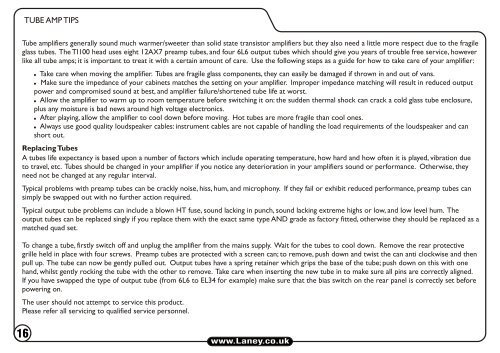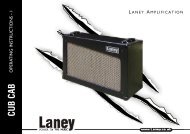TI100 User Manual_2012_Black Cover__Issue 1.3.cdr - Laney
TI100 User Manual_2012_Black Cover__Issue 1.3.cdr - Laney
TI100 User Manual_2012_Black Cover__Issue 1.3.cdr - Laney
- No tags were found...
Create successful ePaper yourself
Turn your PDF publications into a flip-book with our unique Google optimized e-Paper software.
TUBE AMP TIPSTube amplifiers generally sound much warmer/sweeter than solid state transistor amplifiers but they also need a little more respect due to the fragileglass tubes. The <strong>TI100</strong> head uses eight 12AX7 preamp tubes, and four 6L6 output tubes which should give you years of trouble free service, howeverlike all tube amps; it is important to treat it with a certain amount of care. Use the following steps as a guide for how to take care of your amplifier:! Take care when moving the amplifier. Tubes are fragile glass components, they can easily be damaged if thrown in and out of vans.! Make sure the impedance of your cabinets matches the setting on your amplifier. Improper impedance matching will result in reduced outputpower and compromised sound at best, and amplifier failure/shortened tube life at worst.! Allow the amplifier to warm up to room temperature before switching it on: the sudden thermal shock can crack a cold glass tube enclosure,plus any moisture is bad news around high voltage electronics.! After playing, allow the amplifier to cool down before moving. Hot tubes are more fragile than cool ones.! Always use good quality loudspeaker cables: instrument cables are not capable of handling the load requirements of the loudspeaker and canshort out.Replacing TubesA tubes life expectancy is based upon a number of factors which include operating temperature, how hard and how often it is played, vibration dueto travel, etc. Tubes should be changed in your amplifier if you notice any deterioration in your amplifiers sound or performance. Otherwise, theyneed not be changed at any regular interval.Typical problems with preamp tubes can be crackly noise, hiss, hum, and microphony. If they fail or exhibit reduced performance, preamp tubes cansimply be swapped out with no further action required.Typical output tube problems can include a blown HT fuse, sound lacking in punch, sound lacking extreme highs or low, and low level hum. Theoutput tubes can be replaced singly if you replace them with the exact same type AND grade as factory fitted, otherwise they should be replaced as amatched quad set.To change a tube, firstly switch off and unplug the amplifier from the mains supply. Wait for the tubes to cool down. Remove the rear protectivegrille held in place with four screws. Preamp tubes are protected with a screen can; to remove, push down and twist the can anti clockwise and thenpull up. The tube can now be gently pulled out. Output tubes have a spring retainer which grips the base of the tube; push down on this with onehand, whilst gently rocking the tube with the other to remove. Take care when inserting the new tube in to make sure all pins are correctly aligned.If you have swapped the type of output tube (from 6L6 to EL34 for example) make sure that the bias switch on the rear panel is correctly set beforepowering on.The user should not attempt to service this product.Please refer all servicing to qualified service personnel.














